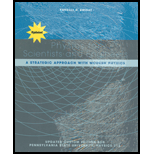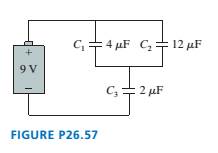
PHYS 212 FOR SCI+ENG W/MAST PHYS >ICP<
1st Edition
ISBN: 9781323834831
Author: Knight
Publisher: PEARSON C
expand_more
expand_more
format_list_bulleted
Concept explainers
Textbook Question
Chapter 26, Problem 57EAP
What are the charge on and the potential difference across
each capacitor in FIGURE P26.57?

Expert Solution & Answer
Want to see the full answer?
Check out a sample textbook solution
Students have asked these similar questions
You're on an interplanetary mission, in an orbit around the Sun. Suppose you make a maneuver that brings your perihelion in closer to the Sun but leaves your aphelion unchanged. Then you must have
Question 2 options:
sped up at perihelion
sped up at aphelion
slowed down at perihelion
slowed down at aphelion
The force of the quadriceps (Fq) and force of the patellar tendon (Fp) is identical (i.e., 1000 N each). In the figure below angle in blue is Θ and the in green is half Θ (i.e., Θ/2). A) Calculate the patellar reaction force (i.e., R resultant vector is the sum of the horizontal component of the quadriceps and patellar tendon force) at the following joint angles: you need to provide a diagram showing the vector and its components for each part. a1) Θ = 160 degrees, a2) Θ = 90 degrees. NOTE: USE ONLY TRIGNOMETRIC FUNCTIONS (SIN/TAN/COS, NO LAW OF COSINES, NO COMPLICATED ALGEBRAIC EQUATIONS OR ANYTHING ELSE, ETC. Question A has 2 parts!
The force of the quadriceps (Fq) and force of the patellar tendon (Fp) is identical (i.e., 1000 N each). In the figure below angle in blue is Θ and the in green is half Θ (i.e., Θ/2). A) Calculate the patellar reaction force (i.e., R resultant vector is the sum of the horizontal component of the quadriceps and patellar tendon force) at the following joint angles: you need to provide a diagram showing the vector and its components for each part. a1) Θ = 160 degrees, a2) Θ = 90 degrees. NOTE: USE DO NOT USE LAW OF COSINES, NO COMPLICATED ALGEBRAIC EQUATIONS OR ANYTHING ELSE, ETC. Question A has 2 parts!
Chapter 26 Solutions
PHYS 212 FOR SCI+ENG W/MAST PHYS >ICP<
Ch. 26 - l. FIGURE Q26.1 shows the x-component of E as a...Ch. 26 - Prob. 2CQCh. 26 - a. Suppose that E =0 V/m throughout some region of...Ch. 26 - Estimate the electric fields and at points 1 and 2...Ch. 26 - Estimate the electric fields and E2 t points 1 and...Ch. 26 - Prob. 6CQCh. 26 - Prob. 7CQCh. 26 - FIGURE Q26.8 shows a negatively charged...Ch. 26 - Prob. 9CQCh. 26 - FIGURE Q26.10 shows a 3 V battery with metal wires...
Ch. 26 - The parallel-plate capacitor in FIGURE Q26.11 is...Ch. 26 - Rank in order, from largest to smallest, the...Ch. 26 - I. What is the potential difference between xi= 10...Ch. 26 - Il What is the potential difference between yi= —5...Ch. 26 - Il FIGURE EX26.3 is a graph of Ex. What is the...Ch. 26 - Il FIGURE EX26.4 is a graph of Ex The potential at...Ch. 26 - Prob. 5EAPCh. 26 - Prob. 6EAPCh. 26 - Prob. 7EAPCh. 26 - I What are the magnitude and direction of the...Ch. 26 - FIGURE EX26.9 shows a graph of V versus x in a...Ch. 26 - Prob. 10EAPCh. 26 - Prob. 11EAPCh. 26 - FIGURE EX26.12 is a graph of V versus x. Draw the...Ch. 26 - Prob. 13EAPCh. 26 - Prob. 14EAPCh. 26 - Prob. 15EAPCh. 26 - Prob. 16EAPCh. 26 - How much work does the charge escalator do to move...Ch. 26 - How much charge does a 9.0 V battery transfer from...Ch. 26 - How much work does the electric motor of a Van de...Ch. 26 - Prob. 20EAPCh. 26 - Two 3.0cm diameter aluminum electrodes are spaced...Ch. 26 - What is the capacitance of the two metal spheres...Ch. 26 - Prob. 23EAPCh. 26 - Prob. 24EAPCh. 26 - 25. A capacitor, a capacitor, and a capacitor
...Ch. 26 - Prob. 26EAPCh. 26 - What is the equivalent capacitance of the three...Ch. 26 - What is the equivalent capacitance of the three...Ch. 26 - You need a capacitance of 50F , but you don't...Ch. 26 - You need a capacitance of 50F , but you don't...Ch. 26 - To what potential should you charge a 1.0F...Ch. 26 - 50pJ of energy is stored in a 2.0cm2.0cm2.0cm...Ch. 26 - A 2.0-cm-diameter parallel-plate capacitor with a...Ch. 26 - The capacitor in a defibrillator unit supplies an...Ch. 26 - Prob. 35EAPCh. 26 - Prob. 36EAPCh. 26 - A typical cell has a layer of negative charge on...Ch. 26 - The electric field in a region of space is...Ch. 26 - Ill The electric field in a region of space is...Ch. 26 - An infinitely long cylinder of radius R has linear...Ch. 26 - Prob. 41EAPCh. 26 - Prob. 42EAPCh. 26 - a. Use the methods of Chapter 25 to find the...Ch. 26 - Prob. 44EAPCh. 26 - Engineers discover that the electric potential...Ch. 26 - The electric potential in a region of space is...Ch. 26 - Prob. 47EAPCh. 26 - Prob. 48EAPCh. 26 - Prob. 49EAPCh. 26 - Prob. 50EAPCh. 26 - Prob. 51EAPCh. 26 - Prob. 52EAPCh. 26 - Prob. 53EAPCh. 26 - Two 2.0 cm × 2.0 cm metal electrodes are spaced...Ch. 26 - Find expressions for the equivalent capacitance of...Ch. 26 - What are the charge on and the potential...Ch. 26 - What are the charge on and the potential...Ch. 26 - Prob. 58EAPCh. 26 - Prob. 59EAPCh. 26 - Six identical capacitors with capacitance C are...Ch. 26 - Prob. 61EAPCh. 26 - A battery with an emf of 60 V is connected to the...Ch. 26 - Prob. 63EAPCh. 26 - Prob. 64EAPCh. 26 - Prob. 65EAPCh. 26 - Prob. 66EAPCh. 26 - Prob. 67EAPCh. 26 - Prob. 68EAPCh. 26 - Prob. 69EAPCh. 26 - Prob. 70EAPCh. 26 - Prob. 71EAPCh. 26 - Prob. 72EAPCh. 26 - Prob. 73EAPCh. 26 - Prob. 74EAPCh. 26 - In Problems 75 through 77 you are given the...Ch. 26 - Prob. 76EAPCh. 26 - Prob. 77EAPCh. 26 -
78. Two 5.0-cm-diameter metal disks separated by...Ch. 26 - Prob. 79EAPCh. 26 - Charge is uniformly distributed with charge...Ch. 26 - Consider a uniformly charged sphere of radius R...Ch. 26 - Prob. 82EAPCh. 26 - Prob. 83EAP
Knowledge Booster
Learn more about
Need a deep-dive on the concept behind this application? Look no further. Learn more about this topic, physics and related others by exploring similar questions and additional content below.Similar questions
- No chatgpt pls will upvotearrow_forwardThe force of the quadriceps (Fq) and force of the patellar tendon (Fp) is identical (i.e., 1000 N each). In the figure below angle in blue is Θ and the in green is half Θ (i.e., Θ/2). A) Calculate the patellar reaction force (i.e., R resultant vector is the sum of the horizontal component of the quadriceps and patellar tendon force) at the following joint angles: you need to provide a diagram showing the vector and its components for each part. a1) Θ = 160 degrees, a2) Θ = 90 degrees. NOTE: USE ONLY TRIGNOMETRIC FUNCTIONS (SIN/TAN/COS, NO LAW OF COSINES, NO COMPLICATED ALGEBRAIC EQUATIONS OR ANYTHING ELSE, ETC. Question A has 2 parts!arrow_forwardNo chatgpt pls will upvotearrow_forward
- No chatgpt pls will upvotearrow_forwardSolve and answer the question correctly please. Thank you!!arrow_forward་ The position of a particle is described by r = (300e 0.5t) mm and 0 = (0.3t²) rad, where t is in seconds. Part A Determine the magnitude of the particle's velocity at the instant t = 1.5 s. Express your answer to three significant figures and include the appropriate units. v = Value Submit Request Answer Part B ? Units Determine the magnitude of the particle's acceleration at the instant t = 1.5 s. Express your answer to three significant figures and include the appropriate units. a = Value A ? Unitsarrow_forward
- Solve and answer the question correctly please. Thank you!!arrow_forwardSolve and answer the question correctly please. Thank you!!arrow_forwardA spiral transition curve is used on railroads to connect a straight portion of the track with a curved portion. (Figure 1) Part A v = v₁ft/s 600 ft y = (106) x³ If the spiral is defined by the equation y = (106)³, where x and y are in feet, determine the magnitude of the acceleration of a train engine moving with a constant speed of v₁ = 30 ft/s when it is at point x = 600 ft. Express your answer to three significant figures and include the appropriate units. ? a = Value Unitsarrow_forward
arrow_back_ios
SEE MORE QUESTIONS
arrow_forward_ios
Recommended textbooks for you
 Physics for Scientists and Engineers, Technology ...PhysicsISBN:9781305116399Author:Raymond A. Serway, John W. JewettPublisher:Cengage Learning
Physics for Scientists and Engineers, Technology ...PhysicsISBN:9781305116399Author:Raymond A. Serway, John W. JewettPublisher:Cengage Learning Physics for Scientists and Engineers: Foundations...PhysicsISBN:9781133939146Author:Katz, Debora M.Publisher:Cengage Learning
Physics for Scientists and Engineers: Foundations...PhysicsISBN:9781133939146Author:Katz, Debora M.Publisher:Cengage Learning
 Physics for Scientists and EngineersPhysicsISBN:9781337553278Author:Raymond A. Serway, John W. JewettPublisher:Cengage Learning
Physics for Scientists and EngineersPhysicsISBN:9781337553278Author:Raymond A. Serway, John W. JewettPublisher:Cengage Learning Physics for Scientists and Engineers with Modern ...PhysicsISBN:9781337553292Author:Raymond A. Serway, John W. JewettPublisher:Cengage Learning
Physics for Scientists and Engineers with Modern ...PhysicsISBN:9781337553292Author:Raymond A. Serway, John W. JewettPublisher:Cengage Learning College PhysicsPhysicsISBN:9781285737027Author:Raymond A. Serway, Chris VuillePublisher:Cengage Learning
College PhysicsPhysicsISBN:9781285737027Author:Raymond A. Serway, Chris VuillePublisher:Cengage Learning

Physics for Scientists and Engineers, Technology ...
Physics
ISBN:9781305116399
Author:Raymond A. Serway, John W. Jewett
Publisher:Cengage Learning

Physics for Scientists and Engineers: Foundations...
Physics
ISBN:9781133939146
Author:Katz, Debora M.
Publisher:Cengage Learning


Physics for Scientists and Engineers
Physics
ISBN:9781337553278
Author:Raymond A. Serway, John W. Jewett
Publisher:Cengage Learning

Physics for Scientists and Engineers with Modern ...
Physics
ISBN:9781337553292
Author:Raymond A. Serway, John W. Jewett
Publisher:Cengage Learning

College Physics
Physics
ISBN:9781285737027
Author:Raymond A. Serway, Chris Vuille
Publisher:Cengage Learning
How To Solve Any Circuit Problem With Capacitors In Series and Parallel Combinations - Physics; Author: The Organic Chemistry Tutor;https://www.youtube.com/watch?v=a-gPuw6JsxQ;License: Standard YouTube License, CC-BY